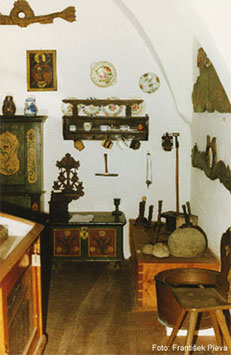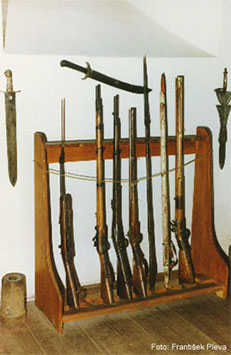Hikes
Ledeč castle
The castle is unbelievably connected to the history of the town. The first mention of Ledeč was in the year 1181 and later in 1186. Until the year 1440 members of the lower Czech nobility resided in Ledeč, thereafter Říčan and Meziříčí from Lomnice held the demesne of Ledeč up-to 1569. Trčkas from Lipa stepped in subsequently. In the year 1677 Ledeč falls into the hands of a foreigner by the name Hadrián from Enkefurt as confiscated property. After him many owners changed hands until the year 1753, in which Ignác from Koch sold the property to Empress Marie Tereza. She later donated it to the Order of Impoverished Noble Women, which she founded. This Order owned it until 1919, the year it came under state administration. Today the castle is private property. The Town Museum is situated there since 1938. An extensive regional collection from early 20th century of travelers’ souvenirs, products and tools of local craftsmen (potters, blacksmiths, dyers etc.), archeological findings, collection of coins and paper money and weapons are on display in this museum.

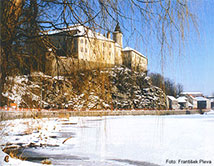
Jewish Cemetery
The Jewish Cemetery in Ledeč was established in the year 1601 after purchasing the land. It is located beyond Hrnčířská Street and the new cemetery. Nearly a thousand citizens of Jewish religion are buried here. They are not only from this town, but also from Vilémovice, Zahrádka, Číhoště and other villages in the surroundings. There had been no burials at this cemetery since 1942. This cemetery is one of the oldest in Bohemia. It is important historically as well as artistically. Most of the gravestones are of Baroque style and the oldest are from the years 1679 and 1706.

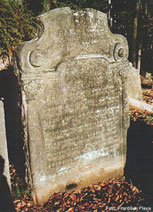
For more information: Information Centre, Tel. 569 721 471
Accessible daily except on Saturdays.
Synagogue
The Jewish Synagogue is situated in close proximity of Husovo náměstí at Na potoce street. It was built in the year 1739 as a replacement to the Synagogue of 1606, which was destroyed by fire. This ground level building is of Country Baroque style. Inside of the arch, there are plastering decorations and a female gallery. The Jewish community of Ledeč disappeared in 1942 as a result of the removal of Jews to concentrations camps. None of them returned to Ledeč. After the war the Synagogue was used as a store house. In 1991 the Synagogue was proclaimed as a cultural memorial. It is interesting to note that the interior of the Synagogue with its arches decorated with plaster designs, today serves the citizens of Ledeč for the purpose of exhibitions and concerts.
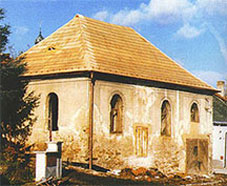
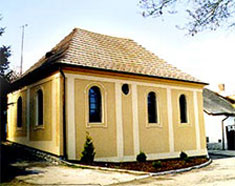
For more information:: Information centre, Tel. 569 721 471
Opened only during exhibitions and concerts.
Conciliation Stone at Koželská street
Conciliation Stone at Koželská street is embedded into the garden wall of the house No. 222 on the left side of Koželská street near the turn to Hůrka. There is a big cross and a sword carved on the stone. There is also a caption saying “ Peter from Kožlí was killed in a dispute A.D.1575 on 1st Thursday. The Legend says that two fathers had a dispute regarding their children and one of them was killed by the other.
The Church of St. Peter and Paul
The church of St.Peter and Paul was built at the beginning of the 14th century. The choir and the northern side chapel of St. Mary are of Gothic style from the period around the year 1400. The chancel is upfolded by a crossed arch with ribs ending in centre console. There are four high windows with nice carved work. During the new reconstruction of the church a cross bar with a carved figure of Jesus Christ was put across the chancel as it was the habit of the Gothic period. The arch of the church is a European rarity. It doesn’t have any other purpose other than decorative. It was made by potters from Ledeč in the 16th century during the most successful period of this craftsmanship in the town.
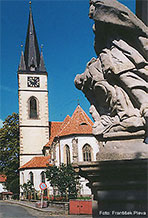
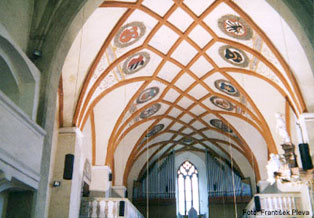
The Holy Trinity Church at the Cemetery
The origin dates back to the year 1585, when the building work was allowed to the town folk by owner of demesne Trčka from Lípa. The inscription inside \“In the year 1585, this temple of the Lord was put up with help of some good citizens of the town Ledeč\”, further testifies the origin of this church. The building is of Renaissance style, single-aisle oblong with pentagonal ending with presbytery and a tower on the southern side of the aisle. The aisle and the presbytery are arched by a tunnel vault with comb structures. The vault interior was built in 1899. There is a pulpit on the outside of the north-western corner.
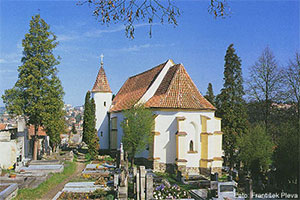
The group of Marian statues at Husovo náměstí
These statutes are standing at the southern side of Husovo náměstí since 1770. The pillar is 11 m tall and the author was Jakub Teplý a sculptor and a carver. The broad pedestal is made up of a quadrilateral granite stone, in the middle there are encomiums of Virgin Mary in Latin. On the four sides, there are statues of Czech patrons – St. Václav, St. Vojtěch, St. Florián and St. Jan Nepomucký. In the middle the pillar lifts itself up with the clouds and the angels ending with the statue of Virgin Mary.
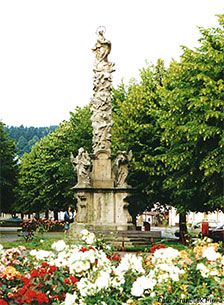
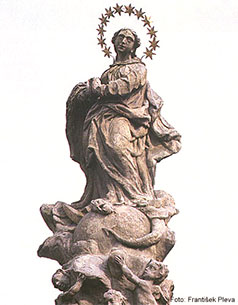
The Statue of Master Jan Hus
The above-life size statue of Master Jan Hus is located at the western side of Hosovo náměstí. The initiative to put up this statue was taken by the local theatre group Tyl in the year 1921, leading to the laying of the foundation stone in the same year. The statue was sculpted out of artificial stone by the Táborian sculptor Rudolf Kabeš. Master Jan Hus is holding an opened book on his right hand, with the inscription “The Truth Wins”. The inscription on the pedestal reads “Love each other in the society, wish everyone the truth”. The statue was unveiled in May 1926 with the participation of a large gathering of the citizens.
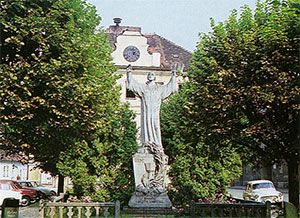
The Statue of St. Jan Nepomucký at the Parish Office
The statue of St. Jan Nepomucký stands on a stone pedestal out of coarse-grain sandstone in front of the decanal church. It is the work of sculptor and carver Jakub Teplý. The inscription on the pedestal reads, \“Swaty Nepomucky Jane ztaviž nas Boha od hanbi wecžně\”
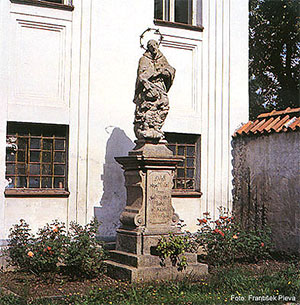
Thunov Country-seat
Thunov country-seat is an early Baroque style building situated in the east of the castle. This building had originated between the years 1685 and 1694 under the ownership of demesne Michal Osvald from Thun, who put it up for his brother Jan Arnošt from Thun, the Archbishop of Salzburg, as his country-seat. The building had been modified in classic style probably in 1800. It is made up of two adjacent buildings – one large square building and the other rectangular with a curb roof. In the past a big park with an orangery, a fountain and large flight of steps with vases belonged to this complex. In the recent past the park has turned into tennis courts. This country-seat was bought by the state of Czechoslovakia, in 1984 it was sold out to the Agricultural Co-operative of Syrovice in Brno. Finally dilapidated.
Town Museum
The Museum is situated at the Ledeč castle, which belongs to one of the oldest survived stone castles in Bohemia (2nd. half of the 13th. century). There is a significant regional display of a collection of arms, coins and paper money in this museum. Short period exhibitions of crea-tions of contemporary artists are held at this museum.
The former military barrack is to be found on the ground floor of the castle in the second court yard. It came into existence on 28th Sept. 1911, and its exhibits were ceremonially de-posited in the castle in 1938. Today the museum has four rooms of exhibits and a repository. There are mainly the things which are reminiscent of the history of the town, the work of the craftsmen of Ledeč area, especially the potters, weavers, dyers, glass-makers, blacksmiths etc. The collection of numismatics, the collection of presents, findings of treasures are great. The quality of the arms collection is very high, and so is the quality of porcelain, glass, clocks and paintings. Various topical exhibitions also take place at the castle.
Opened on
| May–September | April+October | March+November |
|---|---|---|
| Tue–Sun | Sat–Sun | Closed |
| 9.00–12.00 | 9.00–12.00 | |
| 13.00–16.00 | 13.00–16.00 |
Entrance fees: adults 25,-Kč, children 15,- Kč, children up-to 6 years free of charge.
Tel.: 604 564 812
